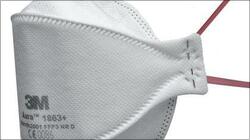Association of Anaesthetists/Anaesthesia Research Grants
Please click the arrows to view each abstract
An observational cohort study to measure carbon dioxide levels and to investigate the physiological and psychological impacts on healthy NHS staff volunteers whilst wearing filtering face piece class 3 (FFP3) respirators
Dr Abhijoy Chakladar
Background
The NHS and Public Health England have made (filtering facepiece class 3; see picture) FFP3 respirators or facemasks compulsory wherever patients with suspected or proven coronavirus are treated. Healthcare workers can spend many hours wearing FFP3 facemasks, during and after which they often experience physical problems such as headaches, drowsiness and reduced hearing.

3m 1863+ FFP3 respirator
One reason for these may be high levels of carbon dioxide in the blood ('hypercarbia'), caused by breathing back in air trapped in the facemask. Although the masks are designed to avoid this problem, we think it may happen if the masks are worn for several hours or more.
Hypercarbia may affect healthcare workers' performance in stressful medical situations, both individually (decision making and speed of thought) and collectively (team performance). This has not been studied before with FFP3 facemasks.
Aims
The primary aim of this study is to measure if blood carbon dioxide levels change when FFP3 facemasks are worn by volunteers, either alone or as part of the 'full' personal protective equipment (PPE) worn in higher risk areas of the hospital.
The secondary aims of this study involve measuring how many symptoms of hypercarbia occur and when, and how personal performance is affected (response times, tiredness and speed of thought) by wearing FFP3 facemasks.
Methodology
Twenty volunteer healthcare workers will take part in the study wearing masks alone for 180 minutes. Of these, a subset of 10 will be chosen at random to repeat the study in 'full' PPE (mask, goggles, surgical hat and gown, gloves) for 180 minutes. Finger pinprick blood tests for hypercarbia will be taken every 30 minutes. The volunteers will be asked about symptoms every 30 minutes, and will have their reaction times tested every 60 minutes. The study will be conducted in a special research unit, away from hospital medical areas.
Expected outcomes & Implications
If we find any performance problems that seem to be caused by hypercarbia, we may be able to redesign FFP3 respirators to avoid them. Also, we might be able to change working conditions so that healthcare workers are more able to look after themselves and their patients when wearing FFP3 masks and PPE.
How can short-course training contribute to excellence in post-operative care in Low-income and Middle-income Countries? An e-Delphi technique study
Dr Søren Kudsk-Iversen
Background
Patients are at the highest risk of surgical complications, such as infection and death, in the month following surgery. This is particularly true for patients having surgery in low- and middle-income countries (LMICs), where complication rates are higher. There are a number of different reasons for the higher rates, including the fact that there are fewer skilled anaesthesia providers. The World Federation of Societies of Anaesthesiologists (WFSA) and the Association of Anaesthetists have developed a number of Safer Anaesthesia From Education (SAFE) courses to support anaesthesia providers. These courses run over 2-4 days and research has shown that they improve the skills and confidence of anaesthesia providers. While some short courses touch upon different aspects of care of patients following surgery, we have not found any courses that look, in detail, at the period after surgery and focus on reducing the risk of complications.
Aims
Working with anaesthesia providers based in LMICs who are trained to teach on SAFE courses (SAFE facilitators) by WFSA, we aim to develop a short course focusing on postoperative care and complications by:
- Defining which key topics should be covered
- Exploring opinions on how to deliver the teaching
- Defining should attend these short courses and who should deliver the teaching
Methods
In order to seek consensus on the aims of the study within different regions of the globe, we will use the e-Delphi technique. The e-Delphi technique, done fully online, works by putting a survey to a group of experts (the panel) and inviting them to score each item by importance. The panel is then sent the survey again, but this time the survey only includes items that had been scored as important by most experts in the previous round. This process is fully anonymous and allows for all voices on the panel to be counted evenly.
To ensure that the final outcomes of the study best represent the views of SAFE facilitators based in LMICs, the study will be done in four stages:
1. We will use published evidence on care and complications following surgery in LMICs to prepare a survey. The survey will include parts focussed on ways of teaching, and on participants and facilitators.
2. We will explore the views of a couple of small groups of SAFE facilitators. Using their experiences, we will review the content and layout of the survey from stage 1. Based on their feedback we will finalise the survey for the e-Delphi technique.
3. We will run three rounds of the e-Delphi technique. Through direct contact and social media, we will invite SAFE facilitators from all countries where SAFE courses have been run by WFSA, with separate panels for different geographical regions.
4. We will show the final consensus-based statements from the e-Delphi technique on a website and will invite feedback from all visitors to the site.
Implications
The consensus-based statements will be used to develop new content for existing short courses or for the creation of a new short course on postoperative care and complications.







